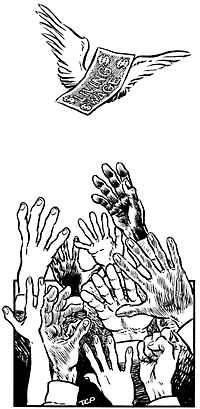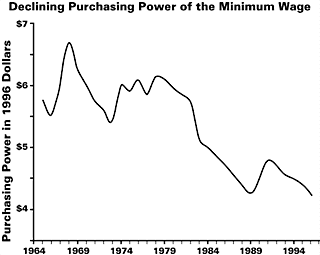https://www.austinchronicle.com/news/1998-03-20/523054/
Out of Reach
Living Wage Eludes the Average Austinite
By Nate Blakeslee, March 20, 1998, News
|
|
A good place to start is Austin's largest employer - the University of Texas. A study commissioned by UT recently discovered what workers there already knew - 94% of non-teaching staff were paid below the market average. But it's not just UT - home of the gold-plated stadium renovations and the $350,000-per-year chancellor - that underpays its workers. Many jobs in Austin barely pay enough to support a single adult, much less a spouse and children.
|
|
The current federal poverty threshold for a family of three is $13,300. A commonly used alternative is 150% of the official figure - which in this case would be about $19,995. That's about $1,108 and $1,666 per month, respectively. The 150% threshold was developed by researchers John Schwarz and Thomas Volgy as a more realistic version of the federal government's threshold, which is still based on a simplistic formula developed in the 1960s: calculating the cost of a minimally sufficient diet and multiplying by three, assuming that most families spent about one-third of their budgets on food. But that formula - which even the original planners believed to be adequate only in times of emergency - fails to take into account the increase in the relative costs of other necessities, such as health care, housing, and transportation, since the 1960s. Now consider the salary figures compiled in the 1997 Austin Area Pay and Benefits Survey, released late last year by the Hay Group, and sponsored in part by the Chamber of Commerce. The average minimum salary for a retail sales clerk in Austin is $14,000. For a data entry operator, $15,500. Administrative assistant, $19,400. Local delivery driver, $15,300. Watchman, $15,900. Janitor, $12,600. Laborer, $13,400. Basic patient care worker, $14,400. Get the picture?
The survey tells a lot of workers what they already know - though at a cover price of $350, the results obviously weren't meant for their eyes (I photocopied my data in the lobby of the Chamber of Commerce). This type of survey is designed for executives, who use it to determine if they are paying their employees the going rate in a given metropolitan area - a handy tool for a mostly non-union area like Austin, where salaries are determined not by collective bargaining, but by ascertaining what the market will bear. Apparently what the market will bear makes for some pretty unbearable jobs, at least for anyone trying to raise a family.
The survey shows that low-wage workers aren't just kids at fast-food restaurants; they are the people that do the essential work that keeps a community functioning. In fact, even workers who earn the bare minimum don't fit the after-school burger-flipper stereotype. Nationwide, the majority of people who earn the minimum wage (about $10,703 per year after Clinton's meager boost to $5.15 per hour) are adults; two-thirds of them are women. And over one-third of minimum wage workers are the sole income earners in their household, according to researcher Holly Sklar, who uses the U.S. Census like a sledgehammer when it comes to poverty myths.
Well, you might say, why don't these workers get a job in Austin's saving grace, the high-tech industry? After all, Samsung just brought 550 new high-tech jobs to Austin. But non-union Samsung pays the going rate for entry-level manufacturing in Austin - about $7.50 per hour, or $15,600 a year - or about the same as a delivery driver. Hardly enough to pull a family out of poverty, or as the Austin Interfaith Council observed back in 1996, hardly enough to merit the $12 million in tax abatements the City of Austin will grant the company in the next five years alone, as part of an incentive package to get the company to locate here. Former mayor Bruce Todd, the great philanthropist, touted the deal as a way to create jobs to get people in Austin off of welfare, and indeed it will. Working at poverty level wages does disqualify you for welfare, although after you lose your Medicaid health insurance, you may wish it hadn't. The working poor - most of whom do not receive benefits from their employers - make up a large percentage of the roughly one in four officially poor people in the country who don't get a dime of government assistance - cash, food stamps, or otherwise.
Under the circumstances, then, it should probably come as no surprise that Austin now has its own version of a "living wage" campaign, a relatively new type of organizing tool whereby municipalities seek to establish a more humane minimum wage within the city limits. As the federal minimum wage has continued to stagnate (it is currently at its lowest level, adjusted for inflation, since 1968), various states, including California and New Jersey, have raised the state minimum wage substantially higher than the federal level. Texas, not surprisingly, hasn't changed its state minimum since the good old days of $3.35 per hour. But many states, including Texas, also allow municipalities to set their own wage floor - and this is where the living wage concept has come into play. Over the last 10 years, living wage measures have been successfully adopted in a number of major cities, such as Boston, St. Paul, Minneapolis, Los Angeles, New Haven, Milwaukee, and Portland, Oregon. The first such initiative in Texas was recently rejected by voters in Houston, following a massive public relations onslaught by an opposition led primarily by the fast-food industry. It was a long, ugly battle, in which pro-initiative forces were outspent roughly 20-1, and the good people of Houston were subjected to gratuitous TV ads featuring old ladies who couldn't afford the sudden rise in grocery prices, hypothetically engendered by greedy minimum-wage workers out to line their pockets with senior citizens' social security checks.
The first meeting of the Austin Living Wage Forum, held last week at the AFL-CIO building, was a little more mundane, bringing together a range of unionists and community activists, as well as elected officials, including Bill Aleshire, Gus Garcia, and Jackie Goodman as panelists, and a brief presentation by noted UT economist James K. Galbraith. Richard Troxell of House the Homeless kicked things off by demonstrating that a person earning the minimum wage - about $750 month after taxes - could scarcely afford the current average rent for an efficiency apartment in Austin, which costs about $427 per month, much less utility bills, food, insurance, and transportation. Using the HUD formula that housing expense should be about one-third of gross income, Troxell calculated that the minimum wage in Austin would have to be raised to $7.39 per hour to provide a living wage.
Galbraith termed the prospects for a successful initiative in Austin "as good as anywhere," noting that Austin's two largest employers - state government and the University of Texas - were unlikely candidates for relocating in response to changes in the city's wage policy. Although the threat of job flight is a commonly invoked opposition argument, in reality, Galbraith pointed out, most low-wage workers are in the service industry, a relatively immobile category.
The consensus at the Living Wage Forum was that the combination of a progressive, activist city council and a tight labor market make this a propitious moment in Austin for seeking a city-wide pay raise. The council does seem attuned to the problem - during the discussion of police salaries, Garcia told the forum, the council discovered that around half of the officers did not live in the city because they could not find affordable housing. And a council initiative is currently in the works to raise the wages of the lowest-paid city workers, eventually up to $9 per hour. But other signs are not so good. For the last three years, the Texas State Employees Union, which represents 2,500 workers in Austin, has been fighting off a move to privatize many state jobs, a move which would mean more part-time workers, less benefits, and generally lower wages. As Jackie Goodman observed, what may be required in Austin is "an evolution in thinking" before overall wage levels can begin to move upward. But considering the rate at which housing and other costs are heading north, applying words like "evolution" to the concept of a fair wage may strike the city's low-wage workforce as a tad cautious and patient, a mode of thinking maybe a little too reminiscent of their own wages - stagnant.
Copyright © 2024 Austin Chronicle Corporation. All rights reserved.


